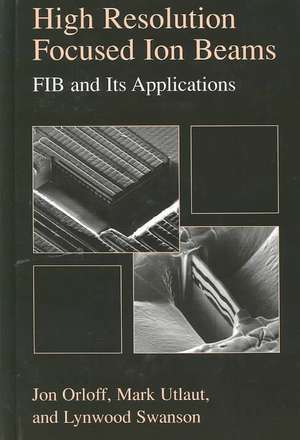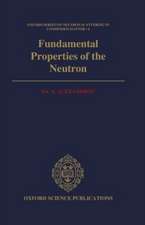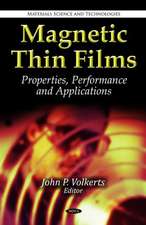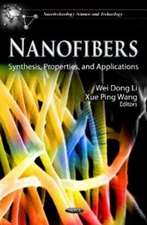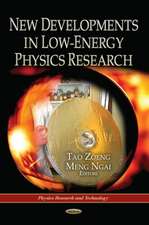High Resolution Focused Ion Beams: FIB and its Applications: The Physics of Liquid Metal Ion Sources and Ion Optics and Their Application to Focused Ion Beam Technology
Autor Jon Orloff, Lynwood Swanson, Mark Utlauten Limba Engleză Hardback – 31 oct 2002
The field of FIBs has advanced rapidly since the application of the first field emission ion sources in the early 1970s. The development of the liquid metal ion source (LMIS) in the late 1960s and early 1970s and its application for FIBs in the late 1970s have resulted in a powerful tool for research and for industry. There have been hundreds of papers written on many aspects of LMIS and FIBs, and a useful and informative book on these subjects was published in 1991 by Phil Prewett and Grame Mair. Because there have been so many new applications and uses found for FIBs in the last ten years we felt that it was time for another book on the subject.
| Toate formatele și edițiile | Preț | Express |
|---|---|---|
| Paperback (1) | 1040.66 lei 17-23 zile | +88.23 lei 4-10 zile |
| Springer Us – 20 sep 2012 | 1040.66 lei 17-23 zile | +88.23 lei 4-10 zile |
| Hardback (1) | 1222.80 lei 6-8 săpt. | |
| Springer Us – 31 oct 2002 | 1222.80 lei 6-8 săpt. |
Preț: 1222.80 lei
Preț vechi: 1491.22 lei
-18% Nou
Puncte Express: 1834
Preț estimativ în valută:
233.99€ • 244.92$ • 194.75£
233.99€ • 244.92$ • 194.75£
Carte tipărită la comandă
Livrare economică 31 martie-14 aprilie
Preluare comenzi: 021 569.72.76
Specificații
ISBN-13: 9780306473500
ISBN-10: 030647350X
Pagini: 304
Ilustrații: XI, 304 p.
Dimensiuni: 155 x 235 x 25 mm
Greutate: 0.59 kg
Ediția:2003
Editura: Springer Us
Colecția Springer
Locul publicării:New York, NY, United States
ISBN-10: 030647350X
Pagini: 304
Ilustrații: XI, 304 p.
Dimensiuni: 155 x 235 x 25 mm
Greutate: 0.59 kg
Ediția:2003
Editura: Springer Us
Colecția Springer
Locul publicării:New York, NY, United States
Public țintă
ResearchCuprins
1. Field Ionization Sources.- 1.1. Gas Field Ionization Sources.- 1.2. Liquid Metal Field Ionization Sources.- 2. Physics of Liquid Metal Ion Sources.- 2.1. Introduction.- 2.2. Theory of LMIS Operation.- 2.3. Early Experiments on Emission of Ions from Liquid Metals (Pre-1975).- 2.4. Ion Production.- 2.5. Theoretical Description of LMIS Behavior.- 2.6. Experimental Studies of LMIS Shape.- 2.7. Later Theoretical Developments: Characterization of Emission.- 2.8. Liquid Flow Characteristics in the LMIS.- 2.9. The Effect of Space Charge on Ion Emission and the Shape of the I–V Characteristic.- 2.10. Low Current Emission.- 2.11. Conclusions Regarding LMIS Theory.- 2.12. LMIS Emission Characteristics.- 2.13. Elements and Alloys Used in LMIS.- 2.14. Energy Distributions.- 2.15. Angular Intensity and Distributions.- 2.16. Noise.- 2.17. Source Lifetime.- 2.18. Emitter Fabrication and Testing Methods.- 2.19. Properties of Materials Used In LMIS.- 3. Ion Optics for LMIS.- 3.1. Introduction.- 3.2. Optical Properties of the LMIS.- 3.3. Review of Charged Particle Optics.- 3.4. Lens Aberrations.- 3.5. Ion Focusing Systems for Field Emission Ion Sources.- 3.6. Wave Optics.- 3.7. Ion Optical Formalism and Resolution.- 3.8. Space Charge Effects.- 3.9. Limits of Resolution.- 3.10. Focusing System Design Considerations.- 4. Interaction of Ions with Solids.- 4.1. Introduction.- 4.2. Energy Losses.- 4.3. Channeling.- 4.4. Damage to the Sample.- 4.5. Sputtering.- 5. Practical Focused Ion Beam Optics and Systems.- 5.1. Introduction.- 5.2. Sources.- 5.3. Practical Focusing Optics.- 5.4. Lens Design.- 5.5. The Deflection System.- 5.6. E x B Mass Filter Design.- 5.7. Beam Alignment Techniques.- 5.8. Real Lens Defects.- 5.9. Magnetic Field Perturbations.- 5.10. Insulator Shielding.- 5.11. CoulombBeam Interactions.- 5.12. Wave Optics vs. Geometrical Optics.- 5.13. How to Evaluate the Performance.- 5.14. Detectors and Imaging.- 5.15. Ion Microscopy: Using Both Ions and Electrons to Image.- 5.16. Collecting Information: Forming Good Images.- 5.17. Imaging and Milling Vexations due to Charging.- 6. Applications of Focused Ion Beams.- 6.1. Introduction.- 6.2. Micro-Machining.- 6.3. Making A Cross-Section Cut.- 6.4. Tem Sample Preparation.- 6.5. Using Sample Damage to Advantage.- 6.6. Deposition of Materials.- 6.7. Enhanced Etch and Deposition.- 6.8. Scanning Ion Microscopy (SIM).- 6.9. Micro-Milling Copper.- 6.10. Access to Die Circuitry from the “Backside”.- 6.11. Secondary Ion Mass Spectrometry (Fib/Sims): The Exploitation of Destruction.- 6.12. FIB Implantation.- 6.13. FIB Lithography.- 6.14. Micro-Mechanical Devices (MEMS).- Appendix 1 Elements of the Theory of Field Desorption and Ionization.- Appendix 2 Table of Sputter Yields.- About the Authors.
